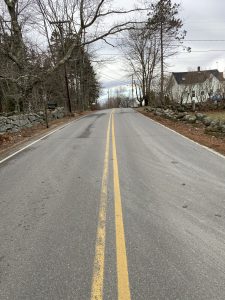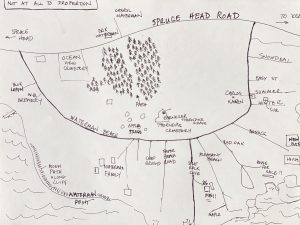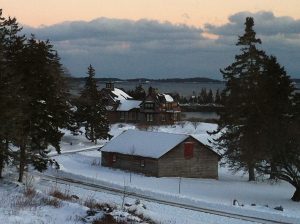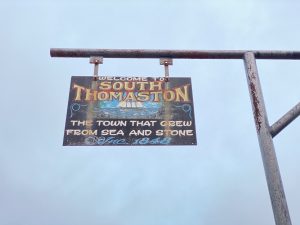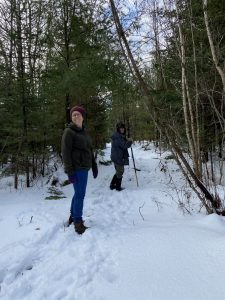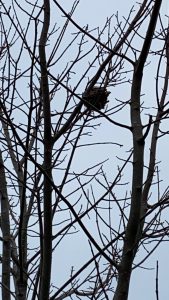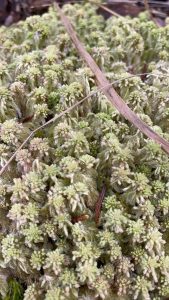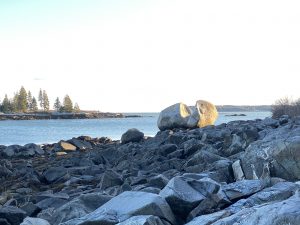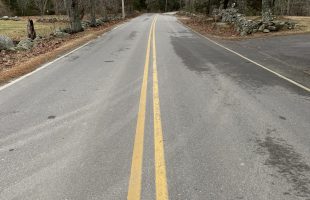
Pursue some path, however narrow and crooked, in which you can walk with love and reverence – Henry David Thoreau
It seemed an easy thing to do. Go take a walk. Walking fulfilled the twin goals of exercise and getting outside during this sheltered-in existence I am living. I just had no idea what it would mean to walk my neighborhood every day for many months.
I began walking in October, an hour every day. I do like exercise, particularly sports, but I lean towards lack of commitment. I need some kind of regimen – a tennis date, a personal trainer, a goal. So I recruited my neighbor, Barbara, or maybe she recruited me, and we put on our walking boots.
Ten years ago, I moved to South Thomaston from Boston, built a house and opened my art residency business. Many of my new friends are artists and writers, curators, and art educators. This is the world as I knew it until the pandemic hit. What began as daily exercise turned into this story.
From the end of our dirt road, Split Rock Cove, Barbara and I really have only two directions to walk – left or right – onto Waterman Beach Road, a u-shaped road that skirts the ocean in Muscle Ridge. From the end of our road it’s about 1 mile either way to the Spruce Head Road, and a much busier road. Barbara’s goal each day is to reach 10,000 steps on her fit bit. I don’t have a fit bit, so my goal is to walk fast enough to raise my heart rate. Plus, we’re good friends, so committing to walking together was easy.
We decided not only to walk to either end of Waterman Beach Road, but to walk up and down the many short side streets that end at the water in our bay. We made this decision in order get more steps into our walks, but quickly found out we could meet new neighbors this way. For instance, we met Carlos, who seems to singlehandedly take care of his short street. After resurfacing the road on day, he stopped, rake in hand for smoothing stone dust, to greet us. We talked about his work, the street, his rental house at the end looking over Nabby Cove. We asked when he and his wife came to South Thomaston and where they were from. Carlos’ wife was the one we met the Saturday that Joe Biden was declared the presidential winner, when she came running out of the house screaming “He won, he won!!” We whooped and hollered with her, and then we introduced ourselves.
It’s become our trademark to stop and talk to whomever we meet, familiar or unfamiliar neighbors. We all love to talk about ourselves – don’t we? – so it isn’t hard to do. People tell us how long they’ve lived here, old-timers tell us what it used to be like on this road, others tell us who is a cousin to whom on our street, and new-comers tell us what they love about Waterman Beach Road. Everyone turns out to be incredibly friendly. This is one of the surprises! Not that people wouldn’t be friendly here. But South Thomaston has a bit of a reputation for its divide between old-timers and those pesky from-away people. The divide can be hurtful, especially since I’m from away. And so I’ve been cautious, having been the target of some of those hurtful remarks.
But we’ve found that sincere curiosity is disarming. A couple of men working on a large metal contraption that looked fairly dangerous were wary when we approached with – Hey, what are you guys making? For a minute, I thought we had made a mistake in crossing the invisible barrier line of old-timers and from-away folks. But we introduced ourselves and told them where we lived. They were curious about us too, it turned out, wanting to know who was living down the dirt road where old German Joe had kept his sheep farm.
They were happy to talk to us about the scallop dredge they were repairing. And while they never stopped working, they showed us their methods and invited me to try the tool they were using to close loops in the metal netting, knowing that the strength needed would be beyond me. But once they saw that I was gaining some purchase on that iron ring, they gave me a hand and closed the ring with me. We had a good laugh at my expense, and I knew that this exchange would likely not have happened pre-walking regimen. We would have waved, maybe. We would not have extended ourselves. I was pretty proud of us!
Barbara and I have walked by pristine houses, and those that feel like junk yards. By that I mean extra cars being used for parts, old bicycles, maybe a boat or two, tires, and a lot of random trash. That’s the way it is in parts of Maine. Not many codes or ordinances here.
South Thomaston is a fishing village, and a seaside working town. Men and women who lobster full time or on the side seem to live in every other house on our street, even if their day jobs are as teachers, or EMT professionals, or computer programmers. Lobstering is in the town’s blood, with traps and gear lining the driveways on our road. The town moniker is, South Thomaston – the town that grew from sea and stone.
We’ve started walking further than just the ends of Waterman Beach Road. First, to expand our fitness regimen, but also because our interests have broadened out and our curiosity has led us into more exploration. We wanted to find a woodland path that would take us off Waterman Beach Road. We asked our nearby neighbor, Richard, who was outside putting new siding on his garage, to help us out. Richard is an accountant – but also a builder, lobsterman, and entrepreneur. He is connected to one of the biggest families here on Waterman Beach Road, the Rackliffe’s. Richard grew up here, went to school here, and pretty much knows everyone, and he loves to share what he knows. But he’s a “live and let live” kind of guy, or maybe a “no harm, no foul” kind of guy. In either case he’s a good neighbor and he knows a lot, but he’s not a gossip. He told us where to find a trail to get us through the woods and over to the Spruce Head Road. Seems the land belongs to a Waterman family member, named Cheryl. It’s not called Waterman Beach Road for nothing. The Waterman family, we’ve learned, have been here since 1866.
Twenty minutes later we had trudged through the path and onto the main road. Across the road we saw a man getting out of his truck, so we, of course, introduced ourselves and said we wanted to make sure it was okay that we had walked through the woods. Being just another kind neighbor, Erik Waterman, said he was sure it was but we could talk with his aunt Cheryl, who lived next door and whose path it is. We talked with Erik a bit (now you see how we’re forgetting about the 10,000 step goal!), and then moved on to go to Cheryl’s house.
It might feel to you like Barbara and I have become somewhat brazen at this point. But we happen to know Cheryl, so this wasn’t a big leap. We headed down her driveway, and a very furry Australian shepherd came out to meet us at the gate. Cheryl, a frontier-type do-it-yourself woman, could be the subject of another entire blog. Suffice it to say, talking with her opened up our walking plans into another whole dimension of possibilities that included the huge wooded acreage behind her house. She assured us that it was okay to walk through her 30 or so acres across the road, but invited us to come another day and walk behind her house to explore the woods and wetlands there.
The pandemic has made the local new, and the nearby a new treasure. We have seen small croppings of houses by walking down side roads and driveways that we’ve never bothered to walk down before. Some of them are neighbors trying to get close to waterfront, others seem to be family compounds. Some of these properties have passed down generations, like those at the end of Pleasant Beach Road. Those folks can easily make their way over to Split Rock Cove through the woods or by kayak. And we do the same.
We’ve stopped to look at wild berries and plants, hummingbird nests, ice patterns on the wetland puddles. We’ve assessed the ways that meadows waft in the wind and why, identified plants and mosses and lichens with my iNaturalist app.
Barbara and I have discovered a mown path along the waterfront that belongs to the Waterman’s, but appears to be accessible (is it really?) to us locals. We’ve become locals, enamored of the woods, the apple tree properties, the many ways that we all try to get our views of the bay. Two of South Thomaston cemeteries are on our route as well. We’ve spent some slow-walking time looking for familiar last names on the gravestones: Rackliffe, Snow, Waterman, Thorndike. In fact, Ebenezer Thorndike arrived here in 1750 from Massachusetts. Heowned 600 acress across what is now South Thomaston and St. George, including the point that includes what we now call Split Rock, but what has been known in town as Thorndike Point.
Our walks are about so much more than walking now, a means, not an end. Walking is an old-fashioned social way to be a neighbor. And we’ve learned again that kindness wins out. Neighbors want to share stories with us. They have lived their varied lives here because they love this place and want to protect it. And we’ve come to appreciate our neighborhood as never before.


